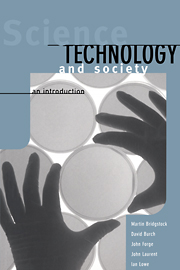Book contents
- Frontmatter
- Contents
- List of Figures
- List of Tables
- List of Contributors
- Preface
- Part One Scientific and Technological Communities
- 1 Introduction
- 2 The Scientific Community
- 3 Responsibility and the Scientist
- 4 The Rights and Wrongs of Science
- 5 Controversies Regarding Science and Technology
- Part Two Scientists and Technologists in the Wider Society
- Appendix 1 Surviving in the Information Jungle
- Appendix 2 Referencing
- Index
3 - Responsibility and the Scientist
Published online by Cambridge University Press: 04 February 2010
- Frontmatter
- Contents
- List of Figures
- List of Tables
- List of Contributors
- Preface
- Part One Scientific and Technological Communities
- 1 Introduction
- 2 The Scientific Community
- 3 Responsibility and the Scientist
- 4 The Rights and Wrongs of Science
- 5 Controversies Regarding Science and Technology
- Part Two Scientists and Technologists in the Wider Society
- Appendix 1 Surviving in the Information Jungle
- Appendix 2 Referencing
- Index
Summary
Michael Polanyi, a chemist turned sociologist of science, tells an interesting story. He recounts that he and the philosopher Bertrand Russell were on the radio in Britain and were asked what practical applications might result from the Einstein formula, E = mc2. Neither of these eminent gentlemen could think of any. The interesting thing about this tale is that it took place in April 1945, a bare three months before the first atomic bomb was dropped, but some forty years after the Einstein formula was discovered and expressed in the special theory of relativity. Polanyi told this story in an essay called ‘The Republic of Science’, first published in 1962, because he wanted to convince his audience that the practical outcomes of pure scientific research were often unforeseen, unforeseeable even, and certainly unintended (Polanyi 1969:58–9). If that were true, then it would not be possible to hold scientists accountable or responsible for their work outside the context of pure science. They would not be answerable in any way for where their work leads and what it enables others to do.
Would it not be better if the scientists were responsible for their work? Certainly, scientists like to claim credit when they do something which helps others. Medical research is one of the best examples. Gene therapy, for instance, is becoming widespread and effective, and it is now possible to treat a number of inherited genetic effects by introducing normal genes into the body (see Weatherall 1991 for many examples).
- Type
- Chapter
- Information
- Science, Technology and SocietyAn Introduction, pp. 40 - 55Publisher: Cambridge University PressPrint publication year: 1998
- 1
- Cited by



